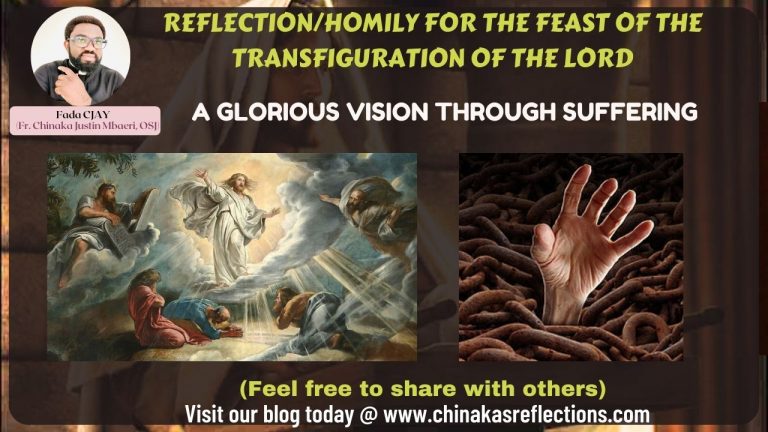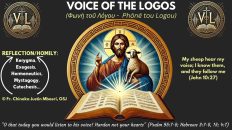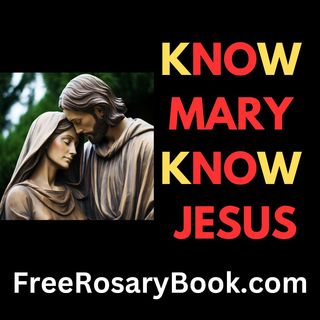A GLORIOUS VISION THROUGH SUFFERING
First Reading: Daniel 7:9-10,13-14
Responsorial Psalm: Ps. 96(97):1-2,5-6,9
Second reading: 2 Peter 1:16-19
Gospel Reading: Matthew 17:1-9
________________________________________
Approximately forty days from now, we shall be celebrating the feast of the Exaltation of the Holy Cross. Needless to say, the Feast of the Transfiguration falls approximately forty days before the Feast of the Exaltation of the Cross on September 14th, because according to tradition, the Transfiguration event took place forty days before the crucifixion. This specific placement connects the glory and transformation of the Transfiguration with the ultimate sacrifice of Jesus on the cross. It reminds us that the journey toward glory involves embracing the cross, and the Transfiguration acts as a prelude to the redemptive work of Christ. The feast of the Transfiguration of the Lord celebrated in the East since the 5th century, has been celebrated in the West since 1457 (15th century). In celebrating the Transfiguration of the Lord, the Church recalls the episode of the transfiguration narrated in the Gospels (cf. Mt 17:1-9; Mk 9:2-10; Lk 9:28-36) and also through an allusion contained in the Second Letter of St. Peter (1:16-18), proposed by the liturgical form as a reading of the book of the prophet Daniel (7-9-10.13-14). Through the celebration of the Transfiguration at this time of the liturgical year, we are invited to understand that the Christian life is not just about suffering and the cross, but also about hope, glory, and positive change. Just as Jesus was transfigured in appearance, we are also called to be transfigured in our interior, renouncing sin and imitating Christ’s example.
Etymologically, the root of the word transfiguration comes from the Greek verb μεταμορφομαι which means metamorphosis (as stated in the Greek biblical text). It’s all about changes in form and/or substance. There is a semantic and semiotic connection with a galaxy of words transversally interconnected. For example, in science, this word would mean nuclear regeneration, microbial transmutation, etc., in medicine, therapeutic procedure, pulmonary resuscitation, etc., in theology, paschal crossing, sacramental transubstantiation, etc., in spirituality, inner healing, spiritual conversion, mystical enlightenment, etc., in psychology, behavioural change, formative character, emotional refinement, etc., in politics, social transformation, ethical revolution, etc., and in education, pedagogical innovation, methodological change, technological transmission, etc. With this knowledge, we can understand the central message of today through the liturgical readings.
The prophet Daniel, in the First Reading (Daniel 7:9-10,13-14) prepares us for the understanding of the Transfiguration of Jesus through the biblical literary form of the apocalyptic vision, which, thanks to the knowledge of the history of the Gospel, we can understand the prophecy in a Christological way. In his vision of the night, Daniel speaks of One of Great Age of a “snow-white robe” and hair “white as wool,” sitting on His throne which was a blaze of flames and wheels of a burning fire, around which the heavenly court is at his service. These are presented with a person who arrived with the clouds of heaven, “like a Son of man,” who is given eternal power, glory and his kingdom that will remain forever. This prophecy is in a Christological key because we read the expression “Son of man” in reference to Jesus, true God and true man (Son of Man and Son of God). Jesus Christ himself used the name “Son of man” to help listeners reflect on his person and mission. In a nexus, it becomes interesting to recall that during the trial before Pilate, Jesus declares himself the Son of Man coming on the clouds of heaven, and for this reason, he was accused of blasphemy, which will lead him to the ignominious death of the cross.
In today’s Psalm (96/97), we sing: “Sing to the Lord a new song; sing to the Lord, all the earth. Sing to the Lord, praise his name; proclaim his salvation day after day…” The psalmist’s call to sing a new song reflects the essence of transformation—just as Christ’s transfiguration was a new revelation of his divine nature. Amidst the trials of our lives, we are encouraged to raise our voices in praise, proclaiming the salvation that is woven into the very depth of our existence. Our struggles do not define us; rather, they become the backdrop against which the radiant glory of the Lord shines even brighter.
And in Peter’s apostolic letter in the Second Reading (2Pt. 1:16-19), we can hear his testimony as a first-hand witness, which becomes for us the hope of what awaits us in eternal life, when we will be like him, as He is, all shining with light. As Peter’s apostolic testimony, we’re reminded of our own journey. Just as Jesus’ transfiguration offered them a glimpse beyond the immediate, Nigeria’s journey invites us to perceive beyond the veil of hardship, to envision a land where justice, equity, and prosperity reign.
Arriving at the Gospel Reading (Matthew 17:1-9), we learn that the conversation between Moses and Elijah signifies an “Exodus”—a journey from suffering to triumph. When Moses and Elijah appeared on the mountain and conversing with our transfigured Saviour, the gospel of Luke tells us that they were speaking of his “Departure” which he was to accomplish in Jerusalem. Now, the word departure as a translation in its original text gives us the term “Exodus”. Exodus actually means departure, in other words. This exodus was to be accomplished in Jerusalem, according to their conversation (Jesus, Moses, and Elijah). What does this really mean? And why are Moses and Elijah discussing it with him? The answer is simple but significant: In the Old Testament, the Prophets Isaiah, Jeremiah, and Ezekiel, over and over again depict the future age of salvation as a new Exodus. When God comes in the future to save his people, he would save them in ways that are similar to the way he saved them at the time of Moses. And Jesus in Luke chapter 9 is the one who would inaugurate that Exodus and accomplish it. Now, this New Exodus is very similar to the Old, and at the same time different from the Old. Both of them are similar because they involve a journey that has a beginning and an end, and it is a journey that sets the people of God free and brings them home to the Promised Land. However, they are different in their location and their destiny. The old exodus begins in Egypt and ended in Jerusalem (Promised land), whereas Jesus’ exodus begins in Jerusalem (where the old exodus ended) and would end in the heavenly promised land (heavenly Jerusalem). That is why Luke’s gospel ends with Jesus not only being raised from the dead but also his ascension into heaven. Therefore, this exodus or departure is the death, resurrection, and ascension into the heavenly promised land. Therefore, the exodus he wishes to accomplish is the heavenly exodus and not the earthly exodus – a transcendent reality, a greater exodus. The only way to do that is through suffering and the cross.
Dear friends in Christ, as we meditate on the account of Christ’s Transfiguration, we are invited to see beyond the veils of suffering that sometimes shroud our vision. Just as the disciples witnessed Christ’s radiant glory beyond his earthly appearance, we too are called to see beyond the surface of our challenges and understand that we are on an exodus with Christ for a better future. In the midst of political unrest and economic hardships, let us cultivate a collective vision for Nigeria—a vision of a nation that transcends its struggles and becomes a guiding light of hope, where shared aspirations eclipse the shadows of division. As we stand at the intersection of suffering and hope, the Feast of the Transfiguration reminds us that change is possible even in the midst of adversity. Just as the disciples bore witness to Christ’s radiant transfiguration, so must we bear witness to the transformational power of unity, hope, and shared dreams. Let us embrace the metamorphosis that turns suffering into strength and challenges into opportunities.
As we partake in the Eucharist today, let us remember that just as Christ’s glory shone through His transfigured form, so can our collective hope shine through the darkest moments, illuminating a path to a Nigeria that flourishes in unity, justice, and prosperity—a Nigeria that stands as a testament to the effective power of hope amidst suffering.
(CLICK HERE FOR THE NEXT SUNDAY’S REFLECTION: REFLECTION/HOMILY FOR THE NINETEENTH SUNDAY IN ORDINARY TIME)
OR
(CLICK HERE FOR THE NEXT DAY’S REFLECTION: REFLECTION/HOMILY FOR MONDAY OF THE EIGHTEENTH WEEK IN ORDINARY TIME)
Shalom!
© Fr. Chinaka Justin Mbaeri, OSJ
Paroquia Nossa Senhora de Loreto, Vila Medeiros, São Paulo, Brazil
nozickcjoe@gmail.com / fadacjay@gmail.com
__________________________
Have you prayed your rosary today?




Amen!
God show Nigeria mercy
As we celebrate the transfiguration of our Lord Jesus Christ today, I pray that God in His infinite mercy visit I and my children, turns our suffering into strength and challenges into opportunities.
Amen
Amen
Amen
Amen.
Amen.
May God help Nigeria get to her own real promised land.
May the Transfiguration of our Lord Jesus Christ, bring about transformation in our lives in Jesus Precious name amen.
Great message with in-depth teaching. May God’s wisdom, knowledge, understanding be with us. May the discerning spirit guide us. Amen